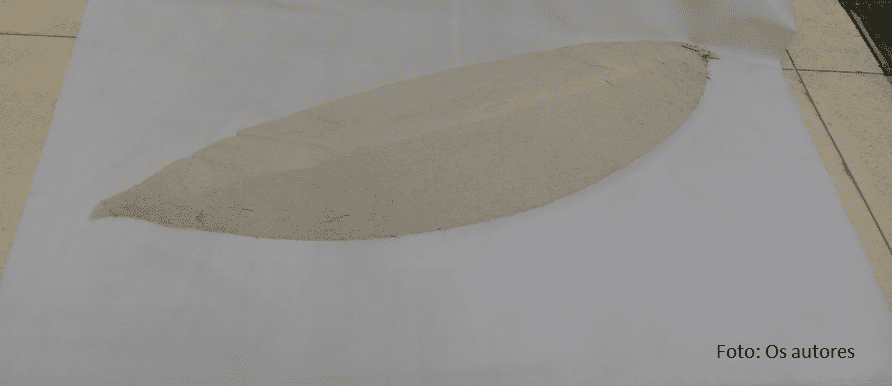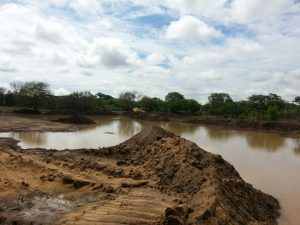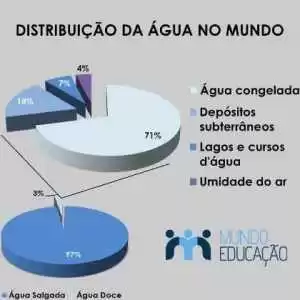ORIGINAL ARTICLE
ANDRADE, Alexsandrea Ricarda Pinheiro [1], PEREIRA, Iara Rafaelle Silva [2], DIAS, Claudio Alberto Gellis de Mattos [3], FECURY, Amanda Alves [4], DENDASCK, Carla Viana [5], DANTAS, Antônio de Pádua Arlindo [6]
ANDRADE, Alexsandrea Ricarda Pinheiro. Et al. Mineralogical analysis of sand sample from Areal Morro Branco in Porto Grande – AP. Revista Científica Multidisciplinar Núcleo do Conhecimento. Year 05, Ed. 03, Vol. 11, pp. 14-20. March 2020. ISSN: 2448-0959, Access Link: https://www.nucleodoconhecimento.com.br/environment/mineralogical-analysis, DOI: 10.32749/nucleodoconhecimento.com.br/environment/mineralogical-analysis
SUMMARY
The municipality of Porto Grande was created on May 1, 1992 and is located in the Northern region of the State of Amapá, with an area of 4 400 km². The objective of this work is to perform the semiquantitative analysis of a sand sample from Areal located in the municipality of Porto Grande, the sample collected went through some fundamental steps such as: drying, moisture determination, determination of clay, silt and sand fractions, homogenization, quarteamento and particle size analysis. In the determination of humidity we obtained the percentage of 2.4%, and this was the difference between the wet mass and the dry mass of our sample P1, after the sieving process, the percentage of the material retained in each sieve was calculated to analyze the performance of our sieving and finally the determination of the clay fractions was performed, which had as weight 0.17 g , silt weighing 24.83 g and sand weighing 275 g. However, at the end of the tests we can observe an anomaly in the results of particle size analysis, due to the fact that the sieve in question would be moist, thus preventing the entire fine granulometry material from passing.
Keywords: Mineralogical Analysis, Porto Grande, sand.
INTRODUCTION
The state of Amapá is one of the 27 federative units in Brazil. Its territory is 142,828,521 km², being delimited by the state of Pará to the west and south, french Guiana to the north, the Atlantic Ocean to the east and Suriname to the northwest. Of the 14.3 million hectares that the state has, 72% are destined to conservation units and indigenous lands). The state is home to the largest national park in the country (Tumucumaque Mountains) (IBGE, 2018).
The municipality of Porto Grande was created on May 1, 1992 and is located in the Northern region of the State of Amapá, with an area of 4 400 km². Economically, Porto Grande stands out as a major producer of fruits such as pineapple and orange, in addition to corn. Public service also moves the region’s economy (IBGE, 2018).
Sand is a material of mineral origin finely divided into granules, composed basically of silicon dioxide, with 0.063 to 2 mm. It is formed on the surface of the Earth by the fragmentation of rocks by erosion, by the action of wind or water, through sedimentation processes can be transformed into sandstone (FERREIRA and DAITX, 2003).
The sand deposits located around the headquarters of the municipality of Porto Grande, state of Amapá, latitude: 00º 42′ 48″ N and Longitude: 51º 24′ 48″ W with an altitude: 60m with an area: 4421.6 km2 in a radius of 4km, are composed of medium-grain sand, quartzwith an average thickness of 8 to 10 meters, sometimes interspersed with lenses of fine sand or pelytic material during the pharerozoic sedimentary cover comprising a numerical scale 358-145 million years. The geometry, dimensions, cubagem and origin of these deposits are not yet well known, they occur close to the contact of the amapaense-coastal floodplain with weathered rocks of the crystalline base (OLIVEIRA, 2010).
They are layers up to 9 meters thick, composed of crispy white sand, moderately to poorly selected, with fine to medium granulometry, sometimes with larger granules and even small clasts. Mineralogy is essentially quartz, and grains are angled to sub-angled. Sedimentary structures of parallel plane bedand stratification are observed tabular to small tangential, with set of varied sizes, truncated by levels enriched in small pebbles (OLIVEIRA, 2010).
Sometimes the local variation can be observed for a finer and poorly selected sand, in addition to the presence of metric layers (up to 2 meters) and matacões of the same diameter, with pelithic material the fine sand in the process of oxidation and lateralization, which give a reddish tone (SHEPHERD and WALSH, 2002).
There are several mineral processes for sand extraction in the region and the activity is quite momentary, being common the temporary shutdown of companies that extract these resources due to the demand of the product by the market. The mining procedure is moderately simple and corresponds to the mechanical dismantling with the aid of a loader and direct loading in a transport truck (SILVA et al., 2006).
GOAL
Perform the mineralogical analysis of a sand sample from Areal Morro Branco in the municipality of Porto Grande – AP.
METHODE
COLLECTION
Three sand samples were manually collected at three points, with elevation points between 71 and 81 m, in morro Branco beach, located in the municipality of Porto Grande in the State of Amapá, on September 14, 2018 (Figure 1).
Figure 1 Shows the manual collection of sand samples from the Morro Branco beach in the municipality of Porto Grande- AP.
DRYING
From the P1 sample, 1kg was selected to be taken to the greenhouse, where it remained for approximately 24 hours, in a separate container the remainder of the P1 sample was placed, which spent the same period in the greenhouse at a temperature between 110°C.
HUMIDITY DETERMINATION
The previously separated 1kg sample was taken from the greenhouse and weighed again, to obtain the amount of moisture that the sample would have lost, for this we used the following equation: Where: U=Humidity / Mu= Wet Dough/ Ms= Dry Dough
Where: U=Humidity / Mu= Wet Dough/ Ms= Dry Dough
HOMOGENIZATION AND QUARTEAMENTO
The rest of the P1 sample that was in the greenhouse was removed to pass through the homogenization processes (Figure 2) and quartation (Figure 3), where homogenization aims to obtain a more uniform distribution of the constituents, thus allowing the quartation into smaller fractions. The quartation operation is carried out with the objective of reducing the mass to be handled for the process, and aims to prepare the sample for chemical, mineralogical particle size analysis where after these processes we took a representative sample of 1 kg.
Figure 2 Shows the homogenization process of sand samples from morro branco beach in the municipality of Porto Grande- AP. Figure 3 Shows the process of quartation of sand samples from the Morro Branco beach in the municipality of Porto Grande- AP.
Figure 3 Shows the process of quartation of sand samples from the Morro Branco beach in the municipality of Porto Grande- AP.
SODIUM SILICATE
12,206g of sodium silicate were separated and deposited in a volumetric flask next to 1L of distilled water. After this, 10 mL of this solution was removed with the help of a pipette and placed in another 100ml volumetric flask.
MECHANICAL DISPERSION
300 g of the P1 sample and approximately 7mL of the sodium silicate solution was removed and placed in a 500 ml becker and completed with distilled water, then this mixture was placed in a mechanical stirrer for approximately 2 hours.
GRANULOMETRIC ANALYSIS
The particle size analysis of the P1 sample was performed in order to determine the dimensions of the particles that make up the sample. With a representative sample, dry sieving was performed, through this we obtained the separation of solid particles in different particle sizes fractions, for this purposes sieves were used with the following openings, 8# – 16# – 35# – 60# – 80# – 100# – 200# – 250# – 325# and 400#. To later be weighed to calculate percentage of accumulated retained and accumulated passerby.
DETERMINATION OF CLAY, SILTE AND SAND FRACTIONS
For this, 400g of the P1 sample with this was subjected to dispersion in 250 mL of solution, with 4 g of sodium hydroxide. After mechanical dispersion, a sieve with an opening mesh of 270# was used to separate the total sand fraction. The material retained in the sieve was washed and dried in an oven at 105°C for 24 hours to then be weighed. The remainder of the suspension, which consisted of silt and clay fractions, was collected in a 1 L beader and the volume was supplemented with distilled water. The suspension was homogenized for 1 hour and left at rest for 24 hours for the sedimentation of the silt fraction. The clay fraction was estimated by hydrometer reading (densimeter) (BOUYOUCOS 1962).
RESULTS AND DISCUSSION
HUMIDITY DETERMINATION
Moisture Determination can be performed in several ways, in this analysis we used the natural moisture content of the P1 sample, of which it was weighed 1046.35 g. Then the sample was taken to the greenhouse with a temperature of approximately 110°C, where it remained for 24 hours. After being removed from the greenhouse, the sample was again weighed and the dry mass of 1020.30 g was obtained, and the difference between the wet masses and the dry mass was the percentage of wet that contained in the P1 sample as seen in the equation:
GRANULOMETRIC ANALYSIS
After the sieving process we weigh the passing material in each sieve and calculate the percentages of this material.
Figure 4 Shows passing material after sieving.
The sieve that had the highest percentage of passerby was 8# where 99.56 passed, due to the granulometry of the sample being fine. According to NBR 6457 – ABNT, fine granulometry is 2 mm (ABNT, 2016).
DETERMINATION OF CLAY, SILTE AND SAND FRACTIONS
Analysis for the determination of fractions of sand, clay and silt resulted in the respective masses of 275 g, 0.17 g and 24.83 g, results corroborated by the literature (SILVA et al., 2009).
CONCLUSION
With the analysis of the P1 sample, we found that the percentage of moisture in the sample was 2.4%, indicating that the site has a small incidence of humidity. It was also found that due to the low granulometry of the sample, 99.56% of the sample passed in the sieve of 8#. With the determination of the fraction of clay, silt and sand, the masses of 275g, 0.17g and 24.83g were determined for sand, clay and silt respectively, indicating that the largest amount of material for this sample is sand, with little amount of clay and relative amount of silt. It is necessary to make a more in-depth study of the sample to determine the percentages of quartz and feldspar existing in this sand.
REFERENCES
ABNT. ABNT/ NBR 6457: amostra de solo: preparação para ensaios de compactação e ensaios de caracterização. Rio de Janeiro RJ: ABNT 2016.
BOUYOUCOS , G. J. Hydrometer method improved for making particle size analysis of soils. Agronomy Journal, v. 54, p. 464‑465, 1962.
FERREIRA, G. C.; DAITX, E. C. A mineração de areia industrial na Região Sul do Brasil. Ouro Preto. R. Esc. Minas, v. 56, n. 1, p. 59-65, 2003.
IBGE. Brasil em Síntese/Amapá/Porto Grande. 2018. Disponível em: < https://cidades.ibge.gov.br/brasil/ap/porto-grande/panorama >. Acesso em: 24 outubro 2018.
OLIVEIRA, M. J. D. DIAGNÓSTICO DO SETOR MINERAL DO ESTADO DO AMAPÁ. Macapá: IEPA, 2010. 148p.
SHEPHERD, K. D.; WALSH, M. G. Development of reflectance spectral libraries for characterization of soil properties. Soil Science Society of America Journal, v. 66, 2002.
SILVA, E. F. et al. Levantamento de reconhecimento de baixa intensidade dos solos do município de Aquidauana‑MS. Rio De Janeiro RJ: Embrapa Solos, 2009.
SILVA, M. D. G. D. et al. Geologia e Recursos Minerais do Estado de Mato Grosso do Sul. Campo Grande MS: CPRM-SEPROTUR, 2006. 121.
[1] Mining Technique. Institute of Basic, Technical and Technological Education of Amapá (IFAP).
[2] Mining Technique. Institute of Basic, Technical and Technological Education of Amapá (IFAP).
[3] Biologist, PhD in Theory and Behavior Research, Professor and researcher of the Degree Course in Chemistry of the Institute of Basic, Technical and Technological Education of Amapá (IFAP).
[4] Biomedical, PhD in Topical Diseases, Professor and researcher of the Medical Course of Macapá Campus, Federal University of Amapá (UNIFAP).
[5] Theologian, PhD in Psychoanalysis, researcher at the Center for Research and Advanced Studies – CEPA.
[6] Materials Technology. Master in Mechanical Engineering, Professor and researcher of the Degree Course in Chemistry of the Institute of Basic, Technical and Technological Education of Amapá (IFAP).
Sent: March, 2020.
Approved: March, 2020.

















